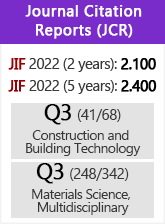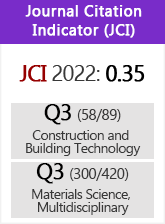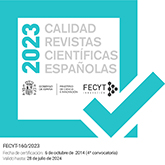Use of dry sludge from waste water treatment plants as an additive in prefabricated concrete brick
DOI:
https://doi.org/10.3989/mc.2002.v52.i267.324Keywords:
dry sludge, waste water, prefabricated concrete, physical properties, mechanical properties, environmental impact, leachingAbstract
Dry sludge from the Sabadell Water Treatment Plant was used to prepare prefabricated concrete bricks. After characterising the sludge and the manufacturing process used to make the bricks, we define the conditions of addition of the sludges in the manufacture. Reference samples not containing sludge and samples containing 2 % of dry sludge by cement weight were prepared. The variation in density, porosity, absorption coefficient and compressive strength of the bricks with the presence of sludge was determined over time. Leaching of the bricks was determined according to the NEN 7345 standard. In most cases the addition of sludge produces a decrease in porosity and absorption coefficients and an increase in compressive strength, so one could expect these bricks to have greater durability. As regards leaching pollutants in the bricks, they are below the limit of the Dutch NEN standard for construction materials and thus can be classified as inert material.
Downloads
Download data is not yet available.
Downloads
Published
2002-09-30
How to Cite
Yagüe, A., Valls, S., Vázquez, E., & Kuchinow, V. (2002). Use of dry sludge from waste water treatment plants as an additive in prefabricated concrete brick. Materiales De Construcción, 52(267), 31–41. https://doi.org/10.3989/mc.2002.v52.i267.324
Issue
Section
Research Articles
License
Copyright (c) 2002 Consejo Superior de Investigaciones Científicas (CSIC)

This work is licensed under a Creative Commons Attribution 4.0 International License.
© CSIC. Manuscripts published in both the printed and online versions of this Journal are the property of Consejo Superior de Investigaciones Científicas, and quoting this source is a requirement for any partial or full reproduction.All contents of this electronic edition, except where otherwise noted, are distributed under a “Creative Commons Attribution 4.0 International” (CC BY 4.0) License. You may read here the basic information and the legal text of the license. The indication of the CC BY 4.0 License must be expressly stated in this way when necessary.
Self-archiving in repositories, personal webpages or similar, of any version other than the published by the Editor, is not allowed.

















